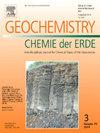利用机器学习和子像素混合算法分析雷萨迪耶(托卡特-图尔基耶)膨润土矿床的地球化学特征并绘制地图
IF 2.9
3区 地球科学
Q2 GEOCHEMISTRY & GEOPHYSICS
引用次数: 0
摘要
re本文章由计算机程序翻译,如有差异,请以英文原文为准。
Geochemical characteristics and mapping of Reşadiye (Tokat-Türkiye) bentonite deposits using machine learning and sub-pixel mixture algorithms
Reşadiye bentonite deposits, which play a significant role in Türkiye's bentonite production, are situated in Central Anatolia. Geochemical, mineralogical, and remote sensing data have been integrated to map the spatial distribution of clay minerals in the bentonite deposits and argillic areas. It is hypothesized that the bentonite samples occurred by the in-situ diagenetic alteration of rhyolite-dacite, trachyte, and andesite/basaltic andesitic composition pyroclastic rocks (ash-flow tuff). Biotite, clinoptilolite, calcite, dolomite, K-feldspar, opal-CT, quartz, and clay minerals are detected in most bentonite samples. The clay patterns determined in the bentonite samples in the X-ray diffraction (XRD) diagrams were 12.3–12.6 Å and were interpreted as being rich in Na-smectites. Mineral mapping in these deposits is essential for mining operations since the high-grade bentonite deposits can be affected by the other clay, gang, and ore minerals they contain in addition to the smectite. The sample spectra measurements matched montmorillonite and kaolin/smectite spectra. This study tests support vector machine (SVM) and artificial neural network (ANN) machine learning and MTMF subpixel algorithms in lithology and mineral mapping in Advanced Spaceborne Thermal Emission and Reflection Radiometer (ASTER) satellite data. It combines the power of subpixel unmixing algorithms to determine the distribution of clay and high-grade bentonites in argillic areas discriminated by machine learning. The results showed that the SVM algorithm can map better than ANN for argillic areas. Additionally, the distribution of high-grade bentonite and kaolin/smectite bearing sites in the study area is discriminated by the mixture-tuned matched filtered (MTMF) spectral classification method. As a result, this study shows that remote sensing studies can be utilized for the exploration and monitoring of high-grade bentonite sites during and/or post-mining operations.
求助全文
通过发布文献求助,成功后即可免费获取论文全文。
去求助
来源期刊

Chemie Der Erde-Geochemistry
地学-地球化学与地球物理
CiteScore
7.10
自引率
0.00%
发文量
40
审稿时长
3.0 months
期刊介绍:
GEOCHEMISTRY was founded as Chemie der Erde 1914 in Jena, and, hence, is one of the oldest journals for geochemistry-related topics.
GEOCHEMISTRY (formerly Chemie der Erde / Geochemistry) publishes original research papers, short communications, reviews of selected topics, and high-class invited review articles addressed at broad geosciences audience. Publications dealing with interdisciplinary questions are particularly welcome. Young scientists are especially encouraged to submit their work. Contributions will be published exclusively in English. The journal, through very personalized consultation and its worldwide distribution, offers entry into the world of international scientific communication, and promotes interdisciplinary discussion on chemical problems in a broad spectrum of geosciences.
The following topics are covered by the expertise of the members of the editorial board (see below):
-cosmochemistry, meteoritics-
igneous, metamorphic, and sedimentary petrology-
volcanology-
low & high temperature geochemistry-
experimental - theoretical - field related studies-
mineralogy - crystallography-
environmental geosciences-
archaeometry
 求助内容:
求助内容: 应助结果提醒方式:
应助结果提醒方式:


